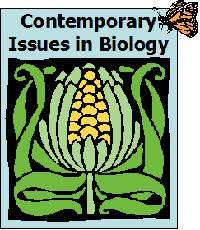
Week 10, Chapter 7 -- Digging Deeper
Course home | Weekly schedule | Announcements | Instructor Info | Desire2Learn | MasteringBiology® | Honor Code | FAQs | HELP!
 |
Week 10, Chapter 7 -- Digging DeeperCourse home | Weekly schedule | Announcements | Instructor Info | Desire2Learn | MasteringBiology® | Honor Code | FAQs | HELP! |
One of the thorniest questions in the science of inheritance is "Is this trait a product of genes, environment, or both?" This week's reading has tried to explain that most interesting human traits are a product of both genes and the environment. Teasing apart their relative contributions is very difficult, and sometimes impossible. Your job this week will be to try to devise an experiment that will help you learn about the methods -- and limitations -- for measuring the heritability of the trait of your choice.
Choose a continuously variable (quantitative) trait in humans or any other organism (see your text for definitions.) With the exception of traits with simple Mendelian inheritance, most features fit this description. (You can tell if it is Mendelian if there are only two or three possible phenotypes). Let your mind be free. Go beyond the obvious features like human skin color, IQ, height, and weight. Think about tail length in cats, the weight of tomatoes produced per plant, the number of mushrooms produced per individual in a particular type of fungus. Think about anything you can observe about any organism – you can choose almost any trait you want, as long as its inheritance is quantitative, not qualitative.
For this assignment, your overall job is to design an experiment that would help you determine the heritability of the trait you chose. For full credit, your assignment must include the following components:
You must include correctly cited links to all references (if any) you used in creating your installment.
The word count should be 450 words or more; you can view a sample assignment here.
Part 2:
Use D2L's spell checker (or the one on your word processor software, which will give you a word count as well). Proofread it yourself too, because spell checkers don't catch everything. When you are satisfied, post your completed assignment in the Digging Deeper forum for this week at the D2L discussion board.
Part 3:
Respond to at least two other students’ explanations. (If you are the first or second person to post, you will have to check back later to complete this part of the assignment). Your response should address whether the experiment would test for heritability and whether the limitations are adequately described.
After you have posted your assignment AND responded to two other students, go to Desire2Learn and complete the Gradebook Declaration for this week's Digging Deeper assignment. (Your Gradebook Declaration is subject to the Honor Code.)
Here is the text of the Desire2Learn Gradebook Declaration: (8 points) I have posted my spell-checked, proofread Digging Deeper assignment
at D2L. My assignment contains all the components listed in the assignment
instructions. |